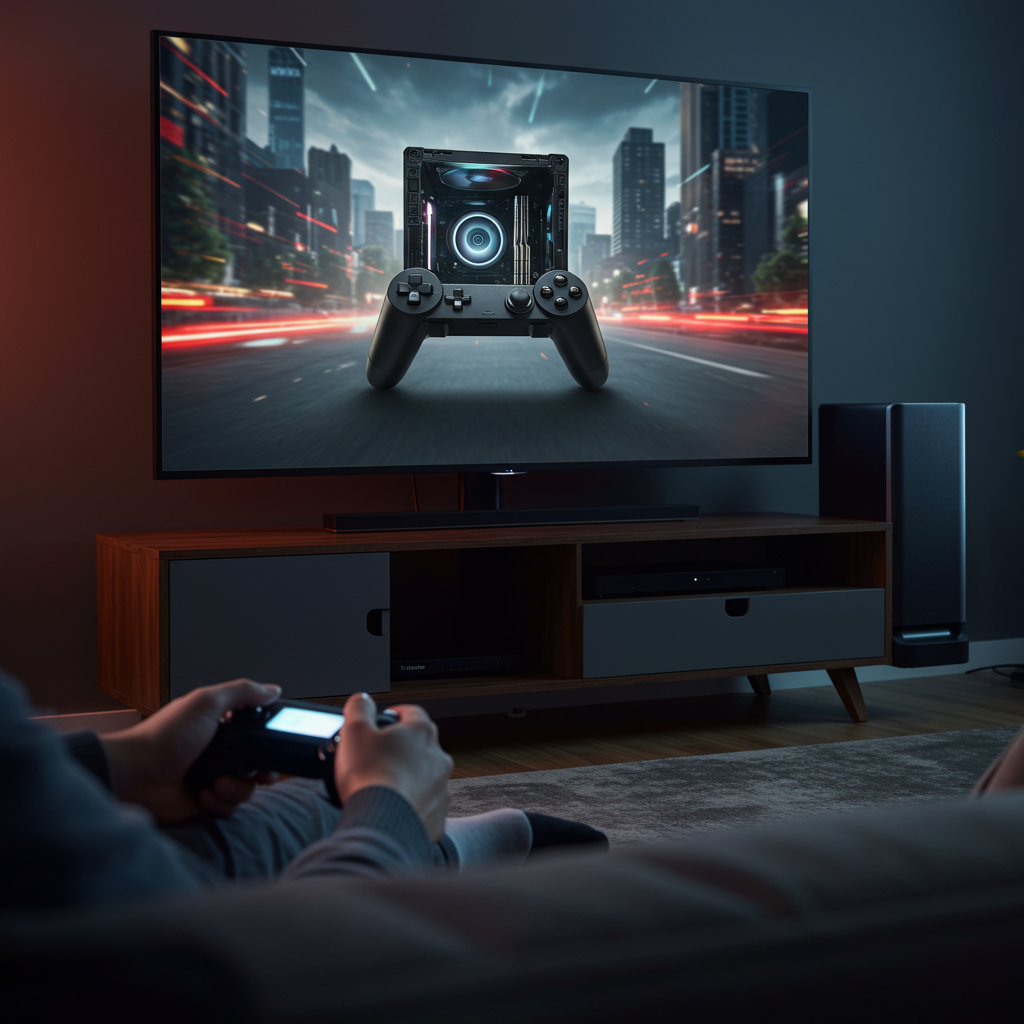For years, the dream of a seamless, powerful PC gaming experience in the living room felt perpetually out of reach. Traditional setups were plagued by noisy laptops, bulky desktops, or Windows interfaces ill-suited for a gamepad-driven couch session. Many, like the author, longed for a single, easily upgradeable platform to conquer their extensive Steam library on the big screen, bypassing the complexities of traditional PC rigs. While Valve’s Steam Deck offered a fantastic handheld solution, it lacked the raw power desired for 4K TV gaming. Previous attempts, like the original Steam Machine experiment, never quite delivered on their promise.
But a new era is dawning for living room PC gaming, thanks to an innovative hardware and software combination: the modular Framework Desktop paired with the clever Linux distribution, Bazzite. This powerful duo is finally bridging the gap, offering a console-like simplicity with PC-grade performance. It’s a testament to how far Linux gaming has come, providing a genuinely viable and exciting alternative for enthusiasts.
Redefining the Living Room Gaming Experience
The Framework Desktop, combined with Bazzite Linux, offers a compelling solution to long-standing living room PC gaming challenges. This setup brings the convenience of a console to the flexibility of PC gaming. Imagine a compact, quiet system that offers 4K/60fps gaming on your TV, easily wakes with a gamepad, and remains smaller than a PlayStation 5. This newfound optimism stems from a remarkably straightforward setup, taking less than an hour to configure.
This ingenious combination mirrors the simplicity of a docked Steam Deck, yet delivers significantly more power. While not as portable as a handheld, its design allows for easy movement. The author found themselves shifting their Framework Desktop between a desk for daytime work and the living room for evening game sessions. This flexibility offers a refreshing separation between productivity and play, an often-overlooked benefit for many users.
The Framework Desktop: A Small Form Factor Powerhouse
The Framework Desktop stands out as an ideal vessel for this console-like PC experience. At a mere 4.5 liters, it’s exceptionally compact, far smaller than most dedicated living room PC gaming computers. Despite its diminutive size, it packs a serious punch, significantly outperforming average home theater PCs or streaming boxes.
Its unique design, highlighted in recent reviews, embraces a different kind of modularity. Rather than allowing individual CPU, GPU, or RAM upgrades (which are integrated into the mainboard’s mobile APU design), the Framework excels at enabling easy mainboard swaps. This innovative approach simplifies maintenance and allows for future generational upgrades by simply swapping the entire mainboard, cooler, and Wi-Fi assembly – a process that takes less than an hour for even novices.
The desktop’s performance is driven by AMD’s Strix Halo APU, integrating both CPU and powerful graphics cores onto a single chip. Configurations range from the Ryzen AI Max 385 APU (8 CPU, 32 graphics cores) to the top-tier Max Plus 395 (16 CPU, 40 graphics cores) with up to 128GB of RAM. The Max Plus 395 version, tested by the author, is claimed to offer performance comparable to an NVIDIA RTX 4070 laptop GPU. This allows for demanding tasks like running large language models and delivers solid 2.5K gaming, or even 4K gaming with optimized settings. Furthermore, its thermal management is excellent, keeping fan noise minimal during most tasks, crucial for a living room PC gaming setup.
Bazzite Linux: The Heart of the Console Experience
Bazzite, an open-source Linux distribution, is truly revolutionizing the living room PC gaming landscape. Described as an open-source take on SteamOS, it closely mimics the Steam Deck’s intuitive game mode and leverages Valve’s Proton compatibility layer to run Windows games seamlessly. For those seeking an alternative to Microsoft Windows, Bazzite offers a remarkably user-friendly escape, whether to avoid Windows 10’s end-of-life or Windows 11’s service pushes.
Beyond gaming, Bazzite provides a capable desktop mode for productivity. Many essential applications like Chrome, Slack, Spotify, Discord, and Signal have native Linux support. Others can run efficiently with compatibility layers like Wine. This flexibility means that if your daily computing is largely web-based, Bazzite on Linux can be a highly effective and liberating platform.
The broader Linux gaming community confirms that “the year of Linux Gaming has already arrived.” Bazzite, built on Fedora Linux, offers a vibrant KDE Plasma desktop environment and integrated software management through Discover. It provides excellent hardware support, including for Intel and NVIDIA, and even enables Android application usage via Waydroid. The power of community-driven platforms like ProtonDB, which rates game compatibility and performance on Linux, makes it easier than ever to gauge whether a title will run flawlessly. Tools like Heroic Games Launcher further expand options, allowing seamless access to games from Epic Games Store, GOG, and Amazon Games.
Simplified Setup and Dual-Booting for Maximum Flexibility
Setting up the Framework Desktop with Bazzite is surprisingly straightforward, especially for those who enjoy a bit of tinkering. The author successfully followed Bazzite’s official guide and Framework’s laptop tutorial, completing the installation in under an hour. Bazzite’s user-friendly ISO picker simplifies downloading the necessary files for installation onto a USB drive.
For optimal versatility, the Framework Desktop’s dual NVMe slots prove invaluable. The author opted to install Bazzite on a separate internal NVMe drive from Windows 11. This strategy reinforces a clear work/play separation and avoids potential boot order disruptions that Windows updates can sometimes cause. While sharing game files across operating systems can be complicated, this dual-drive approach ensures each OS operates independently. The Windows drive is reserved for specific work apps like Lightroom Classic or games requiring it (e.g., PC Game Pass titles, multiplayer games with strict anti-cheat).
Minor technical issues, like an initial lack of HDMI audio, were easily resolved by switching the source in Bazzite’s desktop mode. For convenient transitions, a simple script can be added to Bazzite’s Steam interface. This allows users to reboot directly into Windows without manually accessing boot menus, seamlessly blending both operating systems into a cohesive living room PC gaming setup.
Real-World Gaming Performance: From 4K to Framerate Freedom
The Framework Desktop, especially with the Ryzen AI Max Plus 395 APU, delivers impressive living room PC gaming performance. While its sweet spot is often 2.5K gaming, it can confidently push 4K resolution at around 60 frames per second on a TV, depending on the game and settings. Leveraging technologies like AMD’s FSR (FidelityFX Super Resolution) and frame generation is key to achieving optimal fluidity.
Here’s a snapshot of real-world performance:
Cyberpunk 2077: Achieved around 60fps at 4K on medium settings with FSR balanced, pushing into the mid-80s with frame generation. It’s worth noting that while some benchmarks show higher FPS on discrete GPUs with DLSS, this APU performance is commendable. The author did observe a 15fps slower performance on Linux for Cyberpunk 2077 compared to Windows on the same hardware.
Helldivers 2: Ran at mid-60s in 4K on medium settings, though it could dip to the 40s during intense combat.
Street Fighter 6: Maintained a solid 60fps at 4K with most details set to “normal” (medium).
Monster Hunter Wilds: A demanding title, it achieved 70-80fps at 4K with FSR Performance and medium textures using frame generation, or over 100fps at 2560×1440.
Elden Ring Nightreign: Played at around 50fps in 4K on medium settings, or a locked 60fps at 2.5K.
Peak: Consistently delivered over 80fps at 4K on medium settings.
- Halo: The Master Chief Collection: Showcased excellent performance for older titles, achieving over 300 FPS on Bazzite in tests with a discrete GPU.
- www.theverge.com
- www.tomshardware.com
- www.theverge.com
- www.pcgamer.com
- www.pcgamer.com
However, limitations exist. Some professional apps like Adobe Creative Cloud are incompatible, and certain games from services like PC Game Pass lack support. Multiplayer titles with strict anti-cheat measures, such as Fortnite or Valorant, may also prevent play on Linux. Furthermore, while the 8GB of integrated VRAM is sufficient for many titles at 2.5K or 4K with FSR, extremely demanding modern simulations at native 4K ultra settings might benefit from more dedicated GPU memory.
The Future is Open: A New Era for PC Gaming
The journey to an ideal living room PC gaming setup has been long and winding, but the combination of the Framework Desktop and Bazzite Linux represents a significant breakthrough. It offers a powerful, compact, and user-friendly experience that rivals consoles in its simplicity while retaining the core advantages of PC gaming. This innovative duo embodies the spirit of the triumphant return of the “Steam Machine” concept, a vision Valve initially championed years ago.
For those eager to embrace the open-source spirit and redefine their gaming space, the Framework Desktop running Bazzite Linux is an exciting and highly viable path forward. It’s a testament to continuous innovation in both hardware and software, proving that the future of PC gaming is diverse, flexible, and increasingly accessible from the comfort of your couch.
Frequently Asked Questions
What is Bazzite Linux and how does it enhance PC gaming?
Bazzite Linux is a Fedora-based, open-source operating system designed to provide a console-like living room PC gaming experience. It’s an alternative to SteamOS, incorporating Steam Deck’s game mode and Valve’s Proton compatibility layer to run Windows games seamlessly. Bazzite simplifies the Linux experience with a user-friendly interface, robust hardware support (including for NVIDIA and Intel), and features like the Heroic Games Launcher for non-Steam titles. This makes advanced Linux gaming accessible, allowing players to enjoy a vast library of PC games with minimal fuss on their TV.
Which Framework Desktop configuration is best for living room gaming?
For dedicated living room PC gaming, the higher-end Framework Desktop configurations featuring AMD’s Ryzen AI Max Plus 395 APU are recommended. This model typically includes 16 CPU cores, 40 graphics cores, and ample RAM (e.g., 128GB). While the base 385 APU is capable, the 395 offers significantly more graphics horsepower, enabling smoother 4K gaming at 60fps with optimized settings and frame generation. This configuration provides a powerful, compact system that can handle demanding modern titles while maintaining a quiet operation crucial for a living room environment.
Is a Framework Desktop with Bazzite a viable alternative to a PlayStation 5 or high-end gaming PC?
Yes, a Framework Desktop with Bazzite offers a compelling, console-like alternative for living room PC gaming, especially compared to a PlayStation 5 or bulky gaming PC. It provides the upgradeability and extensive game library of a PC, combined with the compact size and ease of use of a console. While it might not match the raw graphical power of top-tier gaming PCs with discrete GPUs, its AMD Strix Halo APU offers excellent 4K/60fps performance for many titles. It excels for those seeking a quiet, versatile, and open-source gaming hub that also doubles as a productivity machine, though it does have limitations with certain anti-cheat games or professional Windows-only software.



